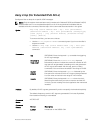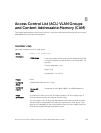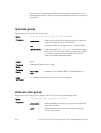
deny icmp (for Extended IPv6 ACLs)
Configure a filter to drop all or specific ICMP messages.
NOTE: Only the options that have been newly introduced in Release 9.3(0.0) and Release 9.4(0.0)
are described here. For a complete description on all of the keywords and variables that are
available with this command, refer the topic of this command discussed earlier in this guide.
Syntax
deny icmp {source address mask | any | host ipv6-address}
{destination address | any | host ipv6-address} [message-type]
[count [byte]] | [log [interval minutes] [threshold-in-msgs
[count]] [monitor]
To remove this filter, you have two choices:
• Use the no seq sequence-number command syntax if you know the filter’s
sequence number
• Use the no deny icmp {source address mask | any | host ipv6-
address} {destination address | any | host ipv6-address}
command
Parameters
log (OPTIONAL) Enter the keyword log to enable the triggering
of ACL log messages.
threshold-in
msgs count
(OPTIONAL) Enter the threshold-in-msgs keyword
followed by a value to indicate the maximum number of ACL
logs that can be generated, exceeding which the generation
of ACL logs is terminated. with the seq, permit, or deny
commands. You can enter a threshold in the range of 1-100.
interval
minutes
(OPTIONAL) Enter the keyword interval followed by the
time period in minutes at which ACL logs must be generated.
You can enter an interval in the range of 1-10 minutes.
monitor (OPTIONAL) Enter the keyword monitor when the rule is
describing the traffic that you want to monitor and the ACL
in which you are creating the rule is applied to the monitored
interface.
Defaults
By default, 10 ACL logs are generated if you do not specify the threshold explicitly.
The default frequency at which ACL logs are generated is 5 minutes. By default,
flow-based monitoring is not enabled.
Command
Modes
ACCESS-LIST
Command
History
Version Description
9.7(0.0) Introduced on the S6000–ON.
Access Control Lists (ACL)
369


















